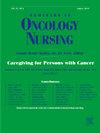Exploring Barriers and Inequalities in Access to Comprehensive Care for Pediatric Oncology Patients: A Systematic Review
IF 2.3
4区 医学
Q1 NURSING
引用次数: 0
Abstract
Objectives
This systematic review aimed to explore and synthesize existing research on the barriers and inequalities in access to comprehensive care for pediatric oncology patients.
Methods
The search was conducted in five databases, including PubMed, Scopus, Web of Science, CINAHL, and APA PsycINFO in December 2024. This review followed PRISMA guidelines and included studies published up to December 2024. Study quality was assessed using Standard Quality Assessment Criteria for Evaluating Primary Research Papers from a Variety of Fields.
Results
Thirteen articles in this systematic reviews identified key barriers to healthcare access, including inadequate infrastructure, workforce shortages, and financial constraints. Socioeconomic disparities, geographic inequities, and racial and ethnic inequalities further exacerbated these challenges. Lower family income was linked to worse outcomes, such as higher chronic graft-versus-host disease rates and late-stage cancer diagnoses. Cross-border residency, clinical trial underrepresentation, and insufficient clinician training also contributed to disparities. Proposed solutions included psychosocial screening, workforce development, financial toxicity mitigation, and policy reforms.
Conclusions
This review highlights the complex and multifaceted barriers affecting equitable access to comprehensive care for pediatric oncology patients. Using a multidimensional perspective, such as the National Institute on Minority Health and Health Disparities Research Framework, our findings suggest that disparities stem from interconnected social, economic, and systemic factors. Addressing these challenges requires a comprehensive, structural, and patient-centered approach to promote equitable healthcare access.
Implications for Nursing Practice
This review underlines the critical role of nursing advocacy, education, and interdisciplinary collaboration in promoting equitable care and addressing disparities within this vulnerable population.
探索儿童肿瘤患者获得综合护理的障碍和不平等:一项系统综述。
目的:本系统综述旨在探讨和综合儿科肿瘤患者获得综合护理的障碍和不平等的现有研究。方法:于2024年12月在PubMed、Scopus、Web of Science、CINAHL、APA PsycINFO等5个数据库中进行检索。该综述遵循PRISMA指南,纳入了截至2024年12月发表的研究。研究质量采用评价不同领域主要研究论文的标准质量评价标准进行评价。结果:本系统综述中的13篇文章确定了获得医疗保健的主要障碍,包括基础设施不足、劳动力短缺和财政限制。社会经济差距、地域不平等以及种族和民族不平等进一步加剧了这些挑战。较低的家庭收入与较差的结果有关,例如较高的慢性移植物抗宿主病发病率和晚期癌症诊断。跨境住院医师、临床试验代表性不足和临床医生培训不足也是造成差异的原因。提出的解决办法包括心理社会筛查、劳动力发展、减轻财务毒性和政策改革。结论:本综述强调了影响儿科肿瘤患者公平获得综合护理的复杂和多方面的障碍。使用多维视角,如国家少数民族健康研究所和健康差异研究框架,我们的研究结果表明,差异源于相互关联的社会、经济和系统因素。应对这些挑战需要一种全面的、结构性的和以患者为中心的方法来促进公平的医疗保健获取。对护理实践的启示:本综述强调了护理宣传、教育和跨学科合作在促进公平护理和解决弱势群体中的差异方面的关键作用。
本文章由计算机程序翻译,如有差异,请以英文原文为准。
求助全文
约1分钟内获得全文
求助全文
来源期刊

Seminars in Oncology Nursing
Nursing-Oncology (nursing)
CiteScore
3.40
自引率
0.00%
发文量
68
审稿时长
45 days
期刊介绍:
Seminars in Oncology Nursing is a unique international journal published six times a year. Each issue offers a multi-faceted overview of a single cancer topic from a selection of expert review articles and disseminates oncology nursing research relevant to patient care, nursing education, management, and policy development.
 求助内容:
求助内容: 应助结果提醒方式:
应助结果提醒方式:


